“Video Games are for boys.”
A sentiment that still, to this day, echoes faintly in my brain -- a dull, residue of old-hat gender politics, staining my sentiments since childhood. From the playground taunts to the blockbuster games that all resembled “male” fare of the time (sports, high budget action movies, knights saving princesses), it was made very clear that I wasn’t invited to the party.
Even in these modern times, when AAA titles like The Last Of Us boast proud, female leads, the slight feeling that one of my main hobbies is restricted from my gender (Assigned Female At Birth) due to societal rule still remains etched in my psyche, like graffiti coated over with dull paint. Peel back the layers, and that message from the 80s and 90s is still there.
However, I consider myself lucky. While younger female gamers would find inspirational figures in Lara Croft, Jill Valentine, or Samus, I managed to find a leading lady who would welcome me into the world of gaming. She was the protagonist that time forgot: Yuko, of Valis: The Fantasm Soldier.
 Super Valis IV
Super Valis IV
Developer: Telenet Japan
Publisher: Telenet Japan - Rerelease By Nintendo
Platforms: Originally PC Enginer Super CD-ROM. Now Nintendo Switch
Price: Included as part of Nintendo Online's Subscription
Release Date: Aug. 23, 1991
Given its relative obscurity, you could imagine my reaction when Nintendo announced Super Valis IV in its latest string of SNES releases to be revived on the Switch. I immediately picked up my controller to start playing this ancient game when I heard the news, but its important to know that Super Valis IV was one of the last entries in this series, and one that I had never gotten to play before.
To truly understand the significance of Valis, we need to explore the previous games in the series, and its pioneering frontwoman.
A Young Gamer Finds Her Heroine
Let’s set the scene by entering a relic of a forgotten age: Blockbuster Video. It’s the early 90s, and a young girl with a backwards Knicks cap firmly planted over her braids peruses the video game section. “Madden? Naw….NBA Jam? Eh, I just rented that last week….Mortal Kombat? Dad will never let me rent that. Wait: what’s this?”

Amidst the sea of box covers with brawny gladiators and dudes who vaguely resemble Sylvester Stallone resides a young warrior woman, brandishing her sword against a giant evil foe. In fact….she’s breaking his weapon with her own! She sort of looks like a crude drawing of Xena: Warrior Princess’ long lost twin sister. Wait...a video game with a FEMALE hero?
“What’s this called? Valis III? Ok, Dad, I got my game for the week, let’s go!”
Before even hitting the start button on my controller, I was hooked. The game opens with an introduction to the villainous Glames. What follows is a cinematic recap of the first two games in the Valis series, with gorgeous anime artwork bathed in sepia tones, overlaid by a dramatic theme song which manages to sound both foreboding and hopeful. Just before the title screen hits, a trio of female characters flash across the screen - each one completely unique from the next. My barely 8-year-old brain nearly exploded....”Hold up, there’s not one, but THREE female warriors in this game?”
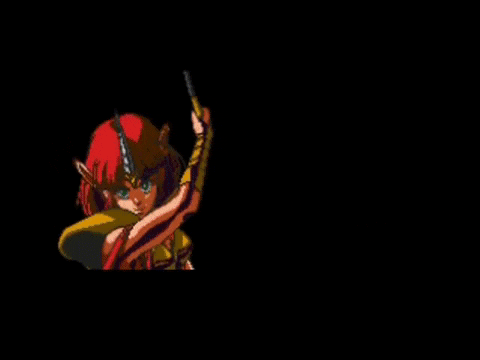
Baby Shanna's Mind: 100% BLOWN.
For the first time as a gamer, I felt seen.
Valis - A Brief, Forgotten, But Rich Series
The original Valis was released in 1986 via Telenet Japan for the PC-88. Popular in Japan, the series produced several sequels, spin-offs, and remakes for multiple platforms, including the Sega Mega Drive, Sega Genesis, PC, and TurboGrafx-16. This was followed by Valis II in 1989, which was only released in the US as Syd Of Valis - a variation of the game with “chibi-style” sprites.
Valis follows the story of high school student Yuko Ahso as she becomes the Fantasm Soldier, facing the evil King Rogles. We’re introduced to Yuko as your every day student, just chatting with her friend / schoolmate Reiko in the rain. Just as Reiko leaves, Yuko is attacked by a vicious monster. In that moment, she hears a voice call out to her and a sword appears in front of her - her destiny as the Fantasm Soldier begins.
To paint a picture, think of Sailor Moon trading in her pretty polished poses for the traits of a valiant valkyrie. It’s a fairly straightforward side-scrolling action game, with gameplay akin to Castlevania. Yuko slashes away at bad guys with her sword, garners power ups, and uses special moves (via magic items and an MP gauge) to battle foes.
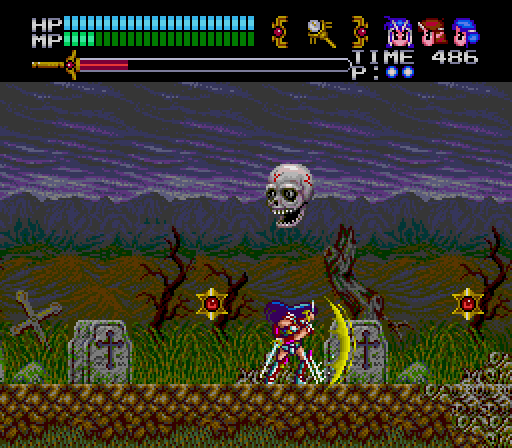
If you've ever played Castlevania or Megaman, you'll be at home here.
Yuko is tasked with defeating King Rogles’ five generals in order to retrieve pieces of the shattered Fantasm Jewel, in order to restore balance back to the world. She is guided by Queen Valia - a goddess-like figure of Dreamland, a planet adjacent to the human world. As the game progresses, we watch our leading lady grow from a reluctant, frightened student to a determined protector and soldier.
One of the unique facets of the series was its eye-catching aesthetics, which stood out against the traditional fantasy setting of most games at the time. Yuko begins in a Japanese city (possibly Tokyo) and traverses worlds such as Vecanti, which takes artistic inspiration from ancient Rome and Athens. The juxtaposition between the urban settings and the Greco-Roman pillars and costume design paint an interesting landscape, which is easy to get lost in.
Valis II followed with a simpler story, with Yuko fighting off the invasion of Rogles’ brother, Megas. A few plot points are made, including the demise of Queen Valia and the introduction of Yuko’s twin sister, Princess Valna. Unfortunately, the chibi-style sprites lessen the impact of the game’s more prevalent moments. It’s a shame that the original Valis II wasn’t released stateside.
However, Valis III provides an incredible pick-up point for anyone new to the series. Upping the ante right off the bat, the game presents the premise that Yuko’s Valis sword was about to clash with the legendary Leethus sword - now owned by the aforementioned Glames - for the first time in millions of years. The Dark World, which Glames ruled, was about to be absorbed into nether space, so he was planning to invade both the Human World and Dreamland by force.
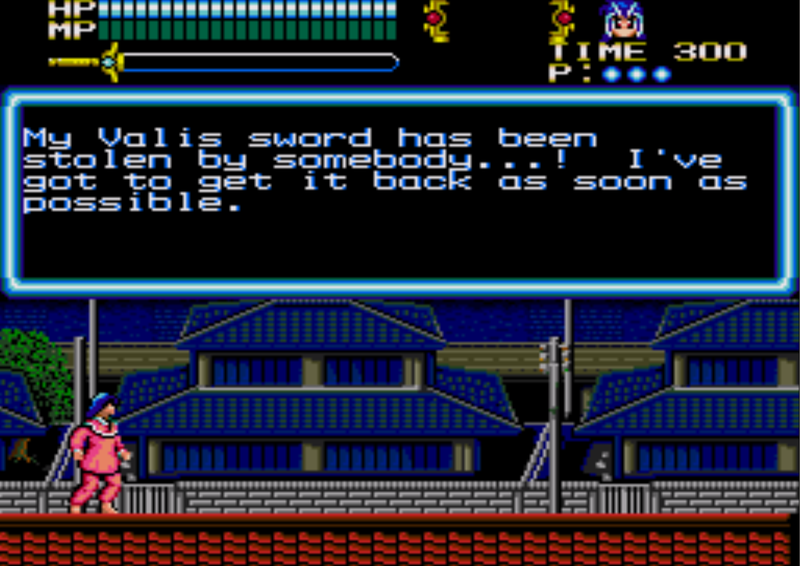
The opening scene of the game immediately draws the player into the story. Yuko is chasing down a thief who stole her precious sword in the middle of the night. The thief is immediately captured by the game’s first boss, dropping the sword in a moment of shock. As it plummets to the ground, Yuko -- still in her pajamas -- leaps off the building after it, eventually catching up to it. With the sword back in her possession, she transforms into the Fantasm Soldier in mid-air, rising up in stoic flight like Superman. Sure, this is all depicted in Sega Genesis 16-bit graphics, but for lil’ Shanna, this was the most epic thing I've ever seen a girl in a video game do.
As mentioned, in Valis III, you have the chance to play as one of three female characters - the titular Yuko, Princess Valna (who serves as your wizard archetype), and Cham, the thief who tried to steal the Valis sword who eventually joins as an ally. She's a more powerful magic user than Yuko, and also has the long range advantage of fighting with a whip.

For a short Sega Genesis game, the storyline of Valis III still holds up. Each level had a purpose to fulfill, rather than just hopping from boss fight to boss fight. The second and third stages are a rescue mission to save Princess Valna, who has been encased in crystal at the top of the tower. Once you rescue her, Princess Valna herself insists on taking on the general who imprisoned her - you fight that boss as Valna, not one of the other “stronger” characters. After this, Yuko must go on a “trial of ordeals” to reach the elder Nizetti, who will release her sword to its full power before she faces Glames and his Leethus blade. As she travels up a literal incline wiping out enemies, illusions of characters from the past games appear to question the motives of the party and ensure they are prepared for the battle ahead. These small elements created a sense of motivation that I never got from games of the time, like Sonic the Hedgehog or Golden Axe….I desperately want to know where the plot was going to go, and what was going to come next.
The Power of Female-focused Storytelling
A defining turnpoint in the original Valis is the fifth general Yuko faces: Reiko. There’s no cutscene to announce this - she just appears as all the previous bosses did. The emotional cutscene when we find out why Reiko sided with the enemy is revealed AFTER you defeat her.
Valis was deep in a way that many games of the time weren’t. Sure, it’s steeped in cheesy melodrama akin to an old school anime like Saint Seiya, but there’s also a pathos in seeing a female character driven to determination by the loss of a friend. Many games of the 80s/90s (along with most media of the age) didn’t weigh in on character development unless a man was losing a love interest; It was incredibly rare to see a character like Reiko, who defended herself or proved some sort of agency, act as a catalyst for another female character’s growth. In fact, it’s in this scene that Reiko confesses to Yuko that she came from an unloving family, and she went to Rogles as an escape. A small touch, but truly ahead of its time when most video games at the time were concerned with bigger graphics, bigger guns, and bigger machismo. Seeing two female characters dealing with sacrifice and loss, in the context of friendship, truly opened my eyes in a way I hadn’t experienced yet as a kid.
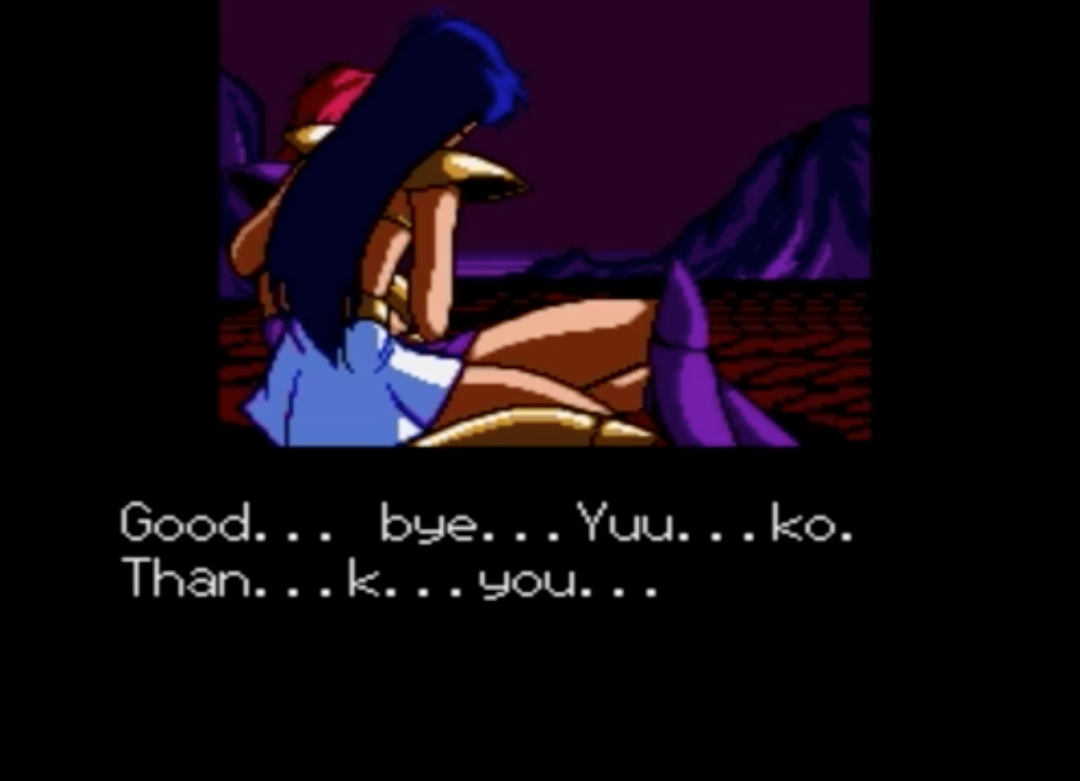
This scene hit 8-year old me very hard - I didn't know games could do this!
There’s also something to be said for the fact that Yuko is mentored by the Queen of Dreamland. Not only do we experience a female in armor, but a female in power.
These ideas were subtly presented, but proved extremely groundbreaking. There’s more to empowering female characters than just sticking them in armor and swords (as years of bad armor “progression systems” have taught us.)
Valis managed to portray traditional “feminine” traits, such as compassion, sympathy, and sisterhood, as strengths, equally balanced alongside swords and physical prowess. It managed to provide a portrait of female equity and fortitude in ways that wouldn’t be seen for many years. Quite impressive for games that barely lasted an hour of playtime.
The Downturn of Valis
Years after I finished Valis III, I waited patiently for the next chapter in the story. After all, the game ended with Yuko ascending to the heavens, with a single line of text that stated she “was never seen again”. There’s got to be more, right?
With renewed interest after seeing this re-release, I started digging to see if there were any Japanese releases I missed... and there were. One is the aforementioned Super Valis IV, which was released on SNES in the States. However, one discovery broke my heart: The release of Valis X -- a 20th anniversary game for Windows in 2006, which happens to be an erotic novel. One of my first heroes, on her 20th Anniversary, had her legacy devolved into a hentai game.
In rewatching the original promo video for the Valis series, the warning signs are there. Between the scant armor, and a few choice “transformation” shots, it’s clear that Yuko was presented in a more sexualized manner for the Japanese release. Akin to Sailor Moon, the overly sexual nature of some of the character designs served as a strange undercurrent to what is otherwise a very progressive, female driven story. Both franchises were steeped in similar themes: a young woman finding her own courage and strength, the idea that compassion can be just as powerful a force as brutal strength, and the idea that a woman could be a competent super hero and savior as a man. It’s a sign of the times, of course, and with the recent release of films such as Wonder Woman 1984 and Captain Marvel, we can at least know that the female heroine has progressed past the need for simple eye candy. Still, as a diehard fan of the series, it was distressing to find out that such a trail-blazing female character, who never really got the accolades she deserved, was (quite literally) stripped of her glory and demoted into a simplistic doll for the male gaze.
The Return Of A Childhood Hero
Even given the discovery of Valis’ plunge into porn, my reverence for the character still hasn’t changed: the impact of Yuko, Cham, and Valna had on me as a child had really been a moment that let me know that there was a place for me in video games. Even if Yuko’s armor didn’t leave much to the imagination, she was still the fierce leader of a female team of women who would go on to save several worlds in their franchise.
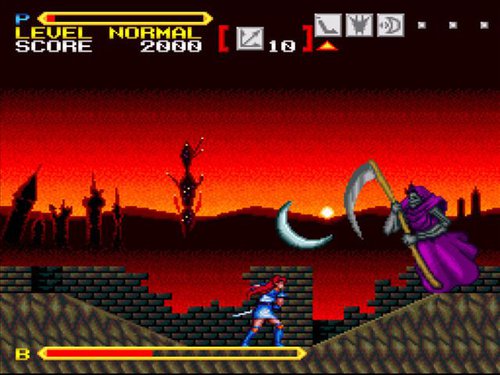
Diving into Super Valis IV on the Switch has provided something beyond nostalgia. Picking up this game series where I had left off, I discovered that Yuko was now a celestial goddess who had passed on the Valis sword to a new Fantasm Soldier named Lena, a plot point that somehow felt more timely than ever. There’s something beautiful (and deeply personal) about revisiting this game series almost 30 years later, and watching my very first video game icon passing the torch on to a new young female. It’s a reminder that even if there are still barriers in the world, I have the strength to pick up my own sword and fight for my seat at the table.
With Nintendo’s release of Super Valis IV on the Switch, perhaps there is a chance that the legacy of the Valis series may be revived. It would be amazing if Yuko finally received the respect she deserves as the powerful groundbreaker she was. In writing this, my hope is that maybe, just maybe, this little love letter to my personal gaming goddess will spark some interest in the series, and inspire a whole new generation of young female gamers to unleash their inner warrior and pick up a controller.
“Video games are for boys,” you say? Step aside - watch this Valkyrie play.